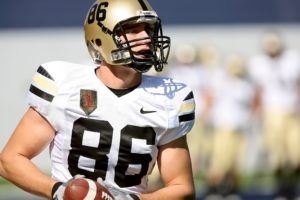Radio Law Talk Segment
Duty of Care Towards Football Players
*We do not get political. We just give the facts and the law.
*Remember this is entertainment, make it interesting and applicable to the general population.
INTRO:
Douglas Randolph has sued the University of Notre Dame, among other defendants for failing to disclose his MRI test results when he suffered an injury on the field while he was at football practice.
FACTS (brief, 6 sentences):
Douglas had an athletic scholarship with the Notre Dame Fighting Irish Football team and was positioned at Linebacker or Defensive end. In September 2015, Douglas was hit during a practice drill. He immediately told his trainer, Rob Hunt that he felt numbness in his extremities. He was sent back on the field after 2 minutes. He continued to feel the symptoms so the team doctor, Dr. Doe A scheduled him for a MRI. Douglas had his MRI but never got to see the actual results of this test and he was told by the team doctor and athletic trainer he could return to practice. He now might sustain permanent nerve damage in his neck because he continued to play college football after he was told it was safe to play.
ISSUES (Summarize both sides argument, both perspectives. You can use bullet points):
- Whether the defendants acted negligently by failing to show Douglas the test results of his MRI test and allowing him to continue playing when they knew of his condition and possible permanent impairment?
- Yes: they breached their duty of care of keeping their players safe by failing to tell him that continuing to play football posed a significant risk to his future health and well-being
- No: they did not owe Douglas a heightened duty of care and Douglas assumed the risk knowing the dangers of playing college football
- Whether the University can be held liable for the football team’s athletic coaches and team doctor’s negligence?
- Yes: the athletic coaches and team doctors behaved negligently and were acting as agents of the University of Notre Dame, thus the school can be held liable for their agents’ negligence
- No: “the standard of care for university sporting events and practices is to avoid reckless or malicious behavior or intentional injury, rather than the reasonable care standard” (Geierbach v. Frieje – Indiana case)
- Thus, the coaches are not liable to the player
- And the university not vicariously liable to player
LAW (with references, no need for blue book citations. This is the most important part, make sure the attorneys can answer any questions from callers on the topic. You can use bullet points):
- The prima facie case for negligence requires a plaintiff to show that the defendant had a duty of care towards the plaintiff, the defendant breached that duty of care, which facutally or proximately caused the injury, and as a result the plaintiff suffered damages.
- In Pinson v. State, a football player had become unconscious twice during practice and the athletic director never informed the hospital doctors; the court found that the athletic trainer breached his duty of care and proximately caused the student’s permanent injuries.
- The defendants might argue that their duty of care is not as high as that of a hospital and thus they did not have the utmost duty of full, honest, and fair disclosure of information (Peterson v. Fairfax Hosp., Sys. 31 Va. Cir. 50)
- Also, defendants might argue that they only have a duty to avoid reckless or malicious behavior or intentional injury because athletes choose to participate in sports (Geiersbach v. Frieje, 807 N.E.2d 114, 118)
- However, this case is more like Nebraska case, Cerny v. Cedar Bluffs Junior/Senior Public School, where the court held that the coaches had a duty to behave as a reasonably prudent person holding a state teaching certificate with a coaching endorsement and should not have allowed the football player (Cerny) to reenter the game when he showed signs of having a concussion. 267 Neb. 958, 969
- Restatement (Second) of Torts §290: the general standard of care is modified in circumstances in which the alleged tort-feasor possesses special knowledge, skill, training, or experience pertaining to the conduct in question that is superior to that of the ordinary person; such a person isn’t held to the standard of a reasonably prudent person, but rather, to a standard consistent with his or her specialized knowledge, skill, and other qualities.
- In Vendrell v. School District, the court found that the football player assumed the risk of being tackled and that the risk of injury inherent in being attacked was obvious. 233 Ore. 1, 5.
- However, this case was distinguished by Thayer v. Oregon Federation of Square Dance Clubs because although the plaintiff assumed the risks inherent in square dancing, she did not assume the risk of a faulty dance floor. 258 Ore. 302, 306
- Thayer might be closer to the case at hand because Douglas assumed the risk without full knowledge of his condition and while being encouraged to continue playing
- Also, defendants might argue that they only have a duty to avoid reckless or malicious behavior or intentional injury because athletes choose to participate in sports (Geiersbach v. Frieje, 807 N.E.2d 114, 118)
DETAILED FACTS (tell the story):
This is a simple, negligence problem, and Defendants should not feel comfortable about this complaint being filed against them. After Douglas was injured at practice, he was sent back on the field 2 minutes after speaking with the athletic trainer about the numbness in his extremities. Although the focus has been on concussions in the NFL with regards to football injuries, this sport poses other threats such as nerve damage. Therefore, an athletic trainer and team doctor could have been reasonably expected to have recognized from the MRI results that it was not in fact safe for Douglas to continue playing football. It is likely that a court will find that this was a breach of their duty to keep their football players safe, and since they were acting as agents of Notre Dame University, the University might also be held liable.
OTHER FACTS (interesting facts, related facts, trivia, etc.):
- John Urschel recently retired from the NFL – he played offensive lineman for the Baltimore Ravens and has been working on his doctorate in math at M.I.T.
- He is 26 years old
- Said that he has had a concussion before while he was working on his doctorate
- He balanced his love for football and the studies revealing many former NFL players showed signs of chronic traumatic encephalopathy, and hung up his cleats
ARTICLE LINKS (so we can print them out):
http://abcnews.go.com/Sports/douglas-randolph-suing-notre-dame-claims-mri-results/story?id=49670328
MEDIA (less than a 2 minutes FUNNY sound bite. You can include a couple of options. We realize that for some topics there is not much):
https://www.youtube.com/watch?v=1T6J8hg7WFs




